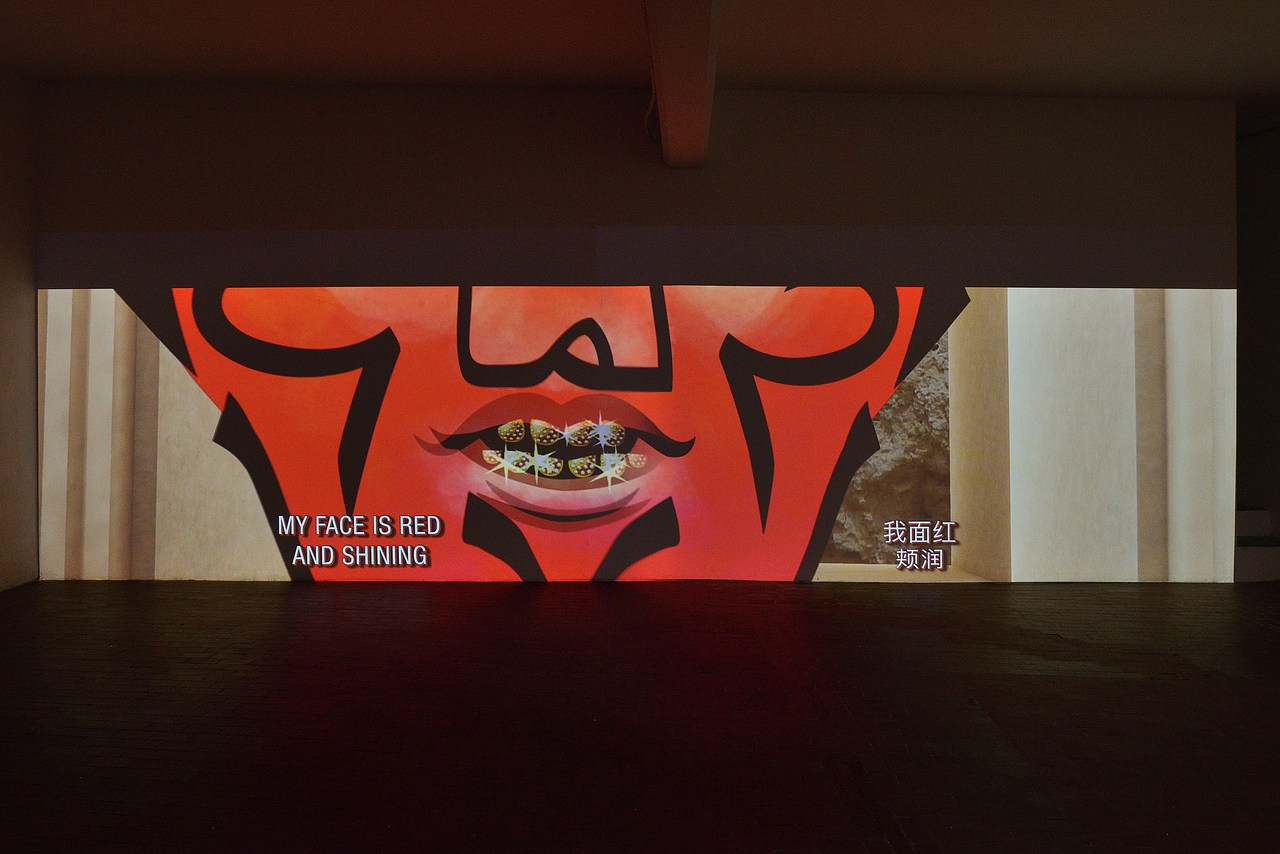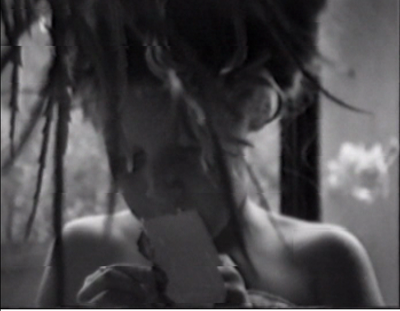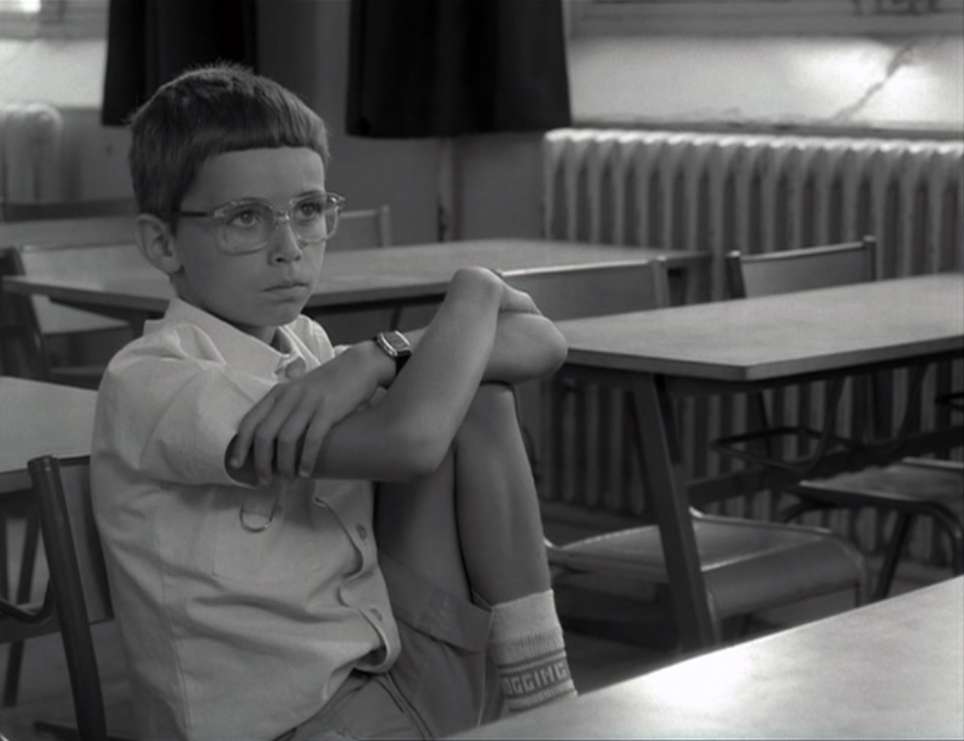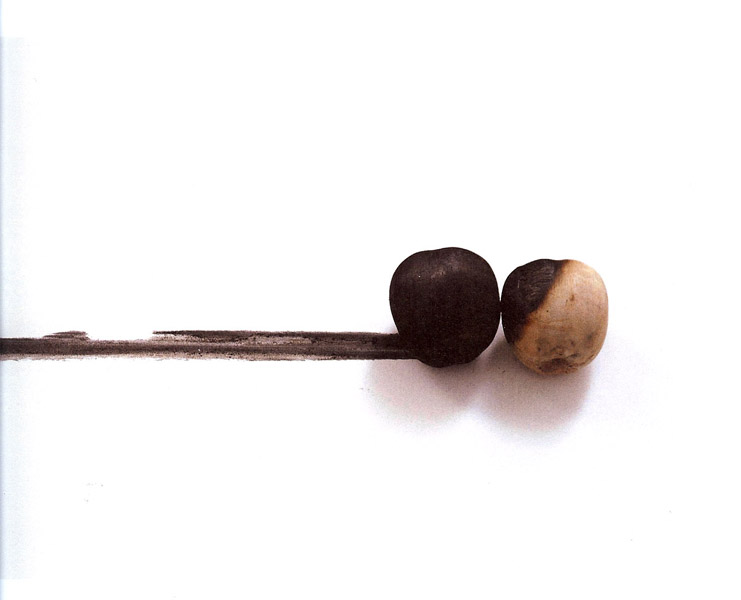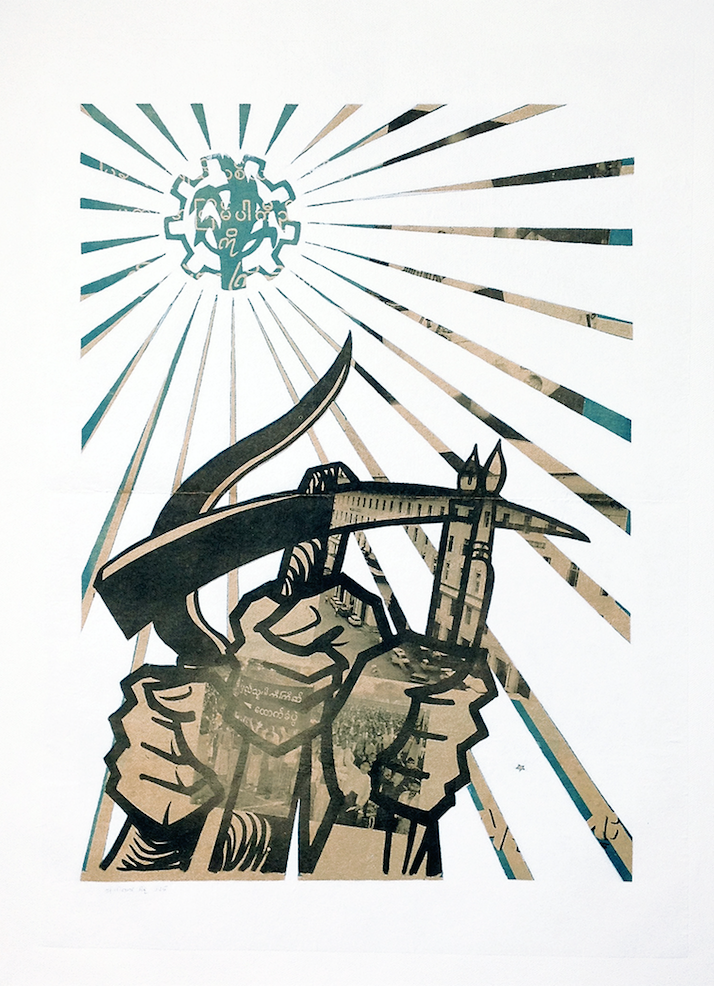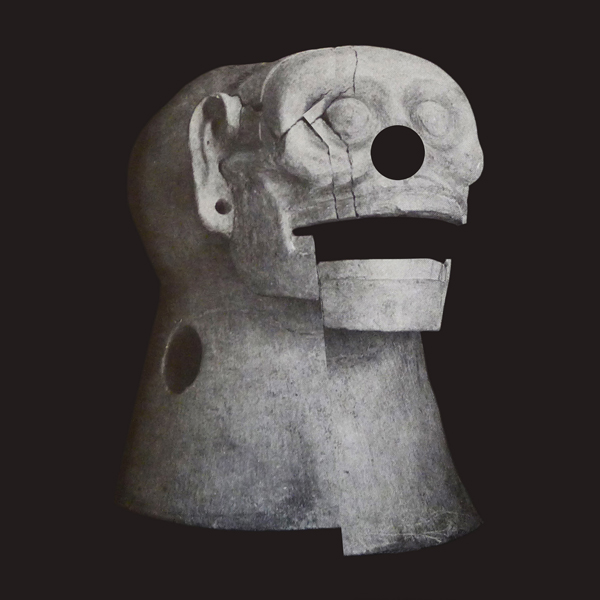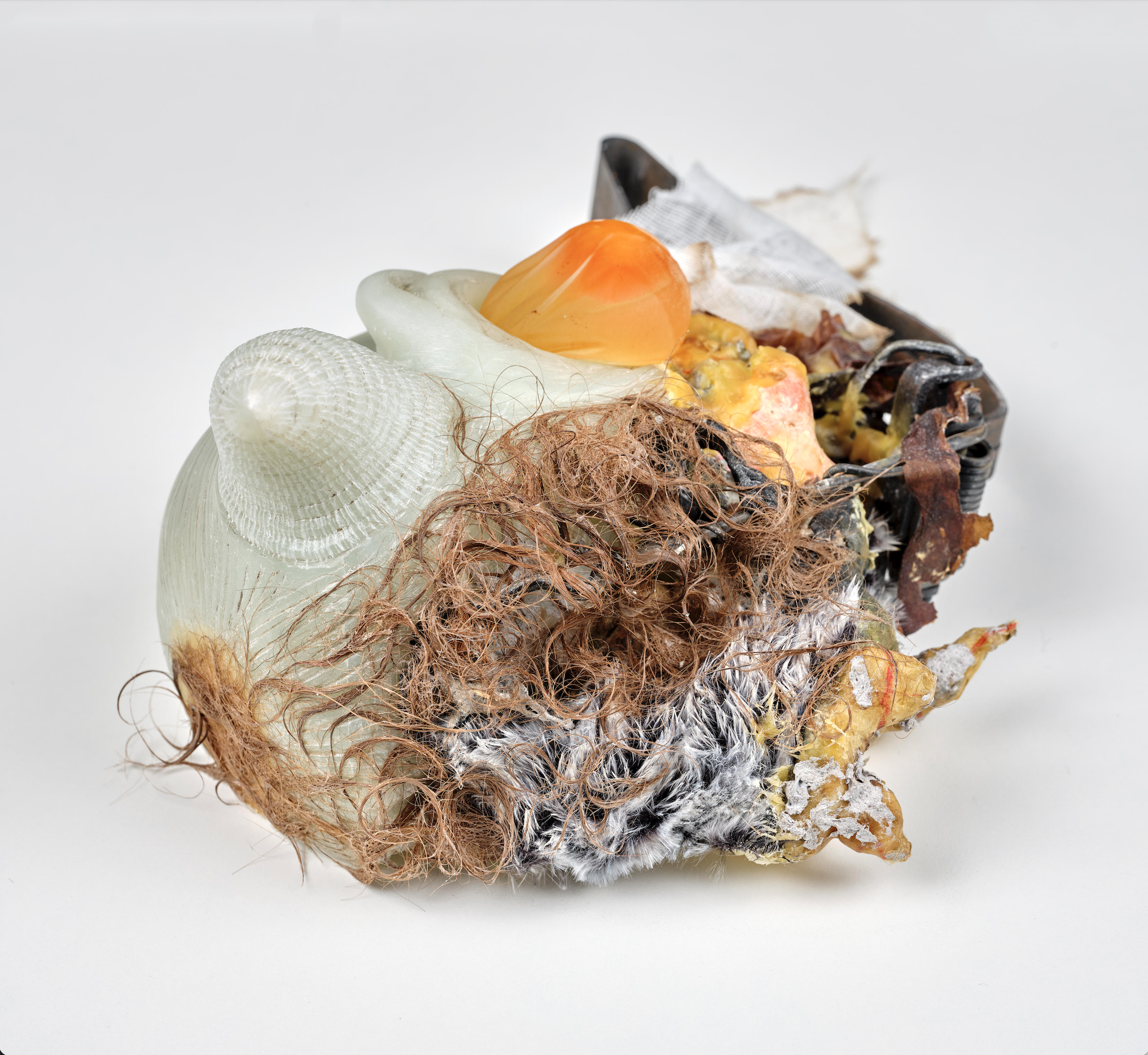
© » KADIST
Miguel and Natalia Fernández de Castro and Mendoza
The Absolute Restoration of All Things is a collaboration by artist Miguel Fernández de Castro and anthropologist Natalia Mendoza. For this project, Fernández de Castro and Mendoza researched the 2014 court case that shut down Penmont Mining’s operations in the middle of the Sonoran desert. The lawsuit was brought to court by the “ejidatarios” (communal land holders) of El Bajío, Sonora, who claimed that their territory was illegally occupied and exploited, causing an irrevocable environmental impact on their land.

© » KADIST
Ana Teresa Fernández
Drawing & Print (Drawing & Print)
The artist writes about her work Borrando la Frontera, a performance done at Tijuana/San Diego border: “I visually erased the train rails that serve as a divider between the US and Mexico. I painted them sky blue, creating a “Hole in the Wall” This deconstruction of “feminized” work explores the difficulties in reconciling both low wages and undervalued work via social and political infrastructures, confronting issues of labor and power. The images that I myself perform, present a duality: women dressed in a black tango dance attire while engaging in de-skilled domestic chores; the surreal within non-fiction.

© » KADIST
Gabriella and Silvana Mangano
There is no there by Gabriella and Silvana Mangano is a black and white looped video with sound, in conjunction with a live performance. The work is inspired by the Blue Blouse, a political propaganda theater movement which spread across the Soviet Union in the mid-1920s. More specifically, the work takes the form of ‘Living Newspapers’, which were performances based on topical news events.

© » KADIST
Slavs and Tatars
Wheat Mollah ( 2011) is one of Slavs and Tatars composite object. The title Wheat Mollah has various interpretations, from “master” or spiritual authority for Shiites and “friend” for Sunnis. The turban is also worn in a diversity of cultures and religions in Africa, Asia and India.

© » KADIST
Michelle and Noel Keserwany
Les Chenilles by Michelle and Noël Keserwany is a sensual film that translates the source of women’s oppression into the means for their liberation. In this narrative film, protagonists Asma and Sarah meet while working as waitresses in France. They both come from the Levant and, each in their own way, carry burdens of the past and the consequences of colonialism.
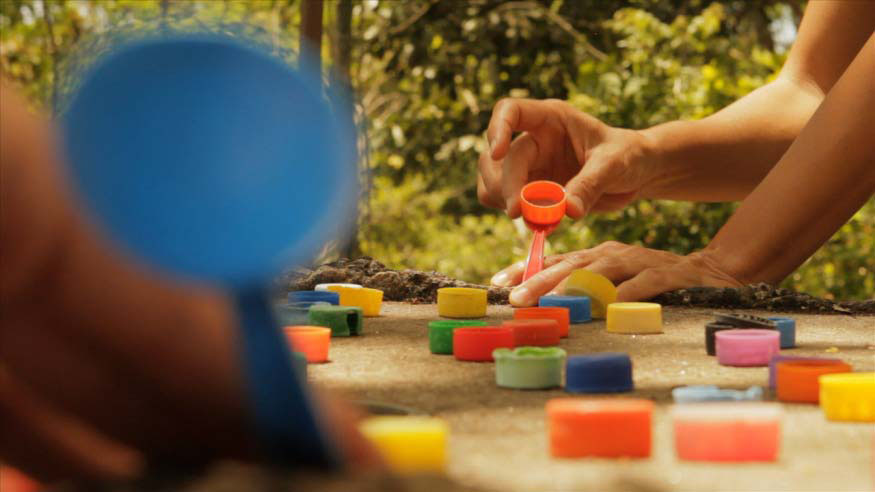
© » KADIST
Donna Conlon and Jonathan Harker
In Tapitapultas (2012), Donna Conlon and Jonathan Harker comment on mass consumerism and pollution by way of a game they invented. The artists used disposable spoons as catapults to shoot thousands of plastic bottle caps at a hole in a concrete platform. The platform was once part of a U. S. military installation in the Panama Canal Zone, and it is now an observation deck in a nature park.

© » KADIST
Köken Ergun and Tashi Lama
Nepal and China signed an agreement for the Belt and Road Initiative (BRI) in 2017. The BRI is a strategy that was set forth by China in 2013 to expand its influence by building a network of economic corridors around the globe. BRI projects in Nepal include the Kathmandu-Kerung Railway, the Galchhi-Rasuwagadhi-Kerung 400 kilovolt transmission line, the 762 megawatt Tamor hydroelectric dam, and the 426 megawatt Phukot Karnali run-of-the-river hydropower project.

© » KADIST
Jay Chung and Takeki Maeda
Jay Chung and Q Takeki Maeda remake a clip from the 1970s they found on the internet, and without really changing this archive material, displace it by imitating the staging and the acting with scrupulous precision. The slightest details are reproduced identically with great minutiae. The facial expressions are absurd, the prim attitude makes no sense.

© » KADIST
Pooja Gurung and Bibhusan Basnet
DADYAA: The Woodpeckers of Rotha by Pooja Gurung and Bibhusan Basnet illuminates a unique and seldom seen international perspective on indigenous cultures and contemporary social issues in the Nepali context. A small masterpiece, the work engages with one of the most pressing social issues in Nepal, mass migration and the dissolving of social fabric in rural areas. The story begins with an old couple, Atimaley and Devi, who live in a village in Jumla, in the highlands of Western Nepal.

© » KADIST
Musquiqui Chihying and Gregor Kasper
Addressing the legacy of colonialism, The Guestbook by Musquiqui Chihying and Gregor Kasper is a slow-paced, black-and-white film exploring the German colony of Togoland, now the Republic of Togo. The guestbook in question—a thin, battered copy that Do Do, the Togolese protagonist of the film, finds in Berlin’s State Library—is filled with the signatures of colonial-era explorers. The plot follows Do Do as he seeks out Treptower Park, where the JAZZ musician Kwassi Bruce was once exhibited in a human zoo in the first German Colonial Exhibition.

© » KADIST
Jonas Van and Juno B
Jonas Van and Juno B’s video work Kebranto is anchored by the figure of Boitatá, a snake that is part of the imaginary Guaraní communities that live between the current nation-states of Argentina, Brazil, Paraguay, and Uruguay. The mythical figure Boitatá is a protector of jungles and forests. In GuaraníBoitatá is the union of two words: Mbói (snake) and tatá (fire).

© » KADIST
Köken Ergun and Satyam Mishra
Nepal and China signed an agreement for the Belt and Road Initiative (BRI) in 2017. The BRI is a strategy that was set forth by China in 2013 to expand its influence by building a network of economic corridors around the globe. BRI projects in Nepal include the Kathmandu-Kerung Railway, the Galchhi-Rasuwagadhi-Kerung 400 kilovolt transmission line, the 762 megawatt Tamor hydroelectric dam, and the 426 megawatt Phukot Karnali run-of-the-river hydropower project.

© » KADIST
Angela Detanico and Rafael Lain
Letters of the Greek alphabet glisten on a black background. When a letter appears, there is a sound. Each letter corresponds to a star in the sky.

© » KADIST
Raimond Chaves and Mantilla Gilda
Many of Chaves and Gilda’s works use recycled cardboard. For Partituras, they arranged stacks of cardboard into long rectangles on the ground, which are visually analogous to fields of graphite in Chaves’s pencil drawings. While the blocks have a spare presence in space, they exist more full solidity within their borders, and the recycled nature of the cardboard adds some play into the clean minimalist rectangles and cubes.

© » KADIST
Chantal Edie and Zacharie Ngnogue
Au non de la liberté (Tiko drink Kumba drunk) is a photographic series by Zacharie Ngnogue and Chantal Edie that considers the correlation between those who hold power in Cameroon and how their actions affect the populations they rule in often compromising ways. “Tiko drink-Kumba drunk” is an adage that is commonly used in the Southwest province of Cameroon to speak of how one’s actions affect others. Civil liberties are next to non-existent in Cameroon, the law is lawless, and structured in a way that is intended to attack its citizens’ human rights.

© » KADIST
Chantal Edie and Zacharie Ngnogue
Au non de la liberté (Tiko drink Kumba drunk) is a photographic series by Zacharie Ngnogue and Chantal Edie that considers the correlation between those who hold power in Cameroon and how their actions affect the populations they rule in often compromising ways. “Tiko drink-Kumba drunk” is an adage that is commonly used in the Southwest province of Cameroon to speak of how one’s actions affect others. Civil liberties are next to non-existent in Cameroon, the law is lawless, and structured in a way that is intended to attack its citizens’ human rights.

© » KADIST
Ana Vaz
Há Terra! (There Is Land!) is a short film by Ana Vaz that picks up on the artist’s previous film A Idade da Pedra (2013), in which Vaz imagined premodernity in her native Brazil.

© » KADIST
Chantal Edie and Zacharie Ngnogue
Au non de la liberté (Tiko drink Kumba drunk) is a photographic series by Zacharie Ngnogue and Chantal Edie that considers the correlation between those who hold power in Cameroon and how their actions affect the populations they rule in often compromising ways. “Tiko drink-Kumba drunk” is an adage that is commonly used in the Southwest province of Cameroon to speak of how one’s actions affect others. Civil liberties are next to non-existent in Cameroon, the law is lawless, and structured in a way that is intended to attack its citizens’ human rights.

© » KADIST
John Lucas and Claudia Rankine
Drawing & Print (Drawing & Print)
Historically, blondeness has been a signifier for desirability and beauty, speaking to “purity” — the purity of whiteness — like no other bodily attribute except, perhaps, blue eyes. In the twenty-first century, blondeness is the look desired by American presidents, pop stars, rappers, television announcers, Hollywood celebrities, the boy next door, and some Asian Americans, African Americans, white Americans, Arab Americans, and LatinX Americans. The desirability of blonde hair has no genre boundaries, no pronoun limitation, and no class limit.

© » KADIST
Olive Martin and Patrick Bernier
The Mohawk, the emblematic Frontier river in the period of American colonisation, is here a cable of data transmission, and the 7 Sultans Casino is a virtual destination, one of the three hundred online casinos hosted by the servers located in Kahnawake, a small native american indian reserve to the south of Montreal. Incorporating poker, challenges to the law, a struggle for the control of a new territory where the stakes are high, our film ‘La Nouvelle Kahnawake’, between fiction and documentary, pushes these analogies with the Western to explore both our relationship to the figure of the ‘Indian’ and the confusion of our perception of space that new information technology has brought about. As the artists state: “We are neither anthropologists nor journalists.

© » KADIST
Pauline Boudry and Renate Lorenz
Salomania sees choreographer and filmmaker Yvonne Rainer and artist Wu Tsang rehearse scenes from Valda’s Solo , a chapter of a film Rainer made in 1972 after having seen women perform the dance of the seven veils in Alla Nazimova’s 1923 silent film Salomé . The script is based on the Biblical New Testament story of the Jewish princess Salomé, who in the Christian tradition has been depicted as an emblem of feminine seduction and danger. In the twentieth century, her character was made popular through English playwright Oscar Wilde’s famous theater piece, Salomé .

© » KADIST
Ei Arakawa and Sergei Tcherepnin
Part of a series entitled “Looking at Listening”, 2011, the piece invited the spectator to experiment and consider sound as a kinetic and synesthetic process, where multiple experiences and senses can cross. The presented photographs were selected from the New York Public Library and found in an archive called ‘Listening,’ with the sub-genres ‘town meetings,’ ‘investigation,’ ‘audiences 1960–1970’ and ‘conversation.’ Taking the photographs from the city’s archive of frozen moments of audio exchange, Arakawa and Tcherepnin give sound and movement back to past moments. In each of the photographs, people are listening in different situations—public, and private.

© » KADIST
John Wood and Paul Harrison
One of John Wood and Paul Harrison’s earliest works, Device features Harrison performing a series of actions, assisted by the titular ‘devices’, that use physics to force his body into unusual and uncomfortable positions. Maintaining his signature deadpan expression throughout the video, in one scene Harrison is thrusted into the air by a slowly inflating balloon until only his feet are visible in the frame, while in another he levitates in diving position with the help of a pulley system. Wood uses his body and specially-designed props created by the artist duo to explore the space of the screen in hilarious, and sometimes clumsy or violent, ways.

© » KADIST
The Propeller Group and Superflex
Fade In (the whole title of the film is actually the entire five page script) is a collaboration with the Danish artist collective Superflex (group of freelance artist–designer–activists committed to social and economic change, founded in 1993 by Jakob Fenger, Rasmus Nielsen and Bjørnstjerne Christiansen). There are several time layers to understand the story behind this film. In 1601, the San Jago set sail from Goa for Lisbon; the cargo included the first consignment of South East Asian porcelain destined for the European market.

© » KADIST
Maayan Amir and Ruti Sela
In Beyond Guilt the two artists create a portrait of our generation in three parts. In Tel Aviv, in confined spaces such as toilets or bar of hotel rooms, they create situations in which participants answer questions and describe themselves. Camera in hand, there is little editing in their works, leaving a rather crude result.

© » KADIST
John Wood and Paul Harrison
3-Legged is an early video work by John Wood and Paul Harrison in which they appear with their legs tied together (as one would do in a three-legged race). Wood and Harrison stand together in a narrow alcove built into their studio, dressed similarly in grey long sleeve shirts and jeans. Facing a tennis ball machine that is almost completely out of view, with only the barrel of the machine protruding from the bottom of the frame, they hobble back and forth across the alcove attempting to avoid the tennis balls launching toward them, with varying degrees of success.

© » KADIST
Köken Ergun and Satyam Mishra
Nepal and China signed an agreement for the Belt and Road Initiative (BRI) in 2017. The BRI is a strategy that was set forth by China in 2013 to expand its influence by building a network of economic corridors around the globe. BRI projects in Nepal include the Kathmandu-Kerung Railway, the Galchhi-Rasuwagadhi-Kerung 400 kilovolt transmission line, the 762 megawatt Tamor hydroelectric dam, and the 426 megawatt Phukot Karnali run-of-the-river hydropower project.

© » KADIST
Ana Navas
Ana Navas uses humor to address formal, aesthetic, and societal conventions that are interwoven in the everyday through the normalization of gendered behaviors and style choices used to project personal and collective signifiers. In her Donation Vases she uses quotes taken from corporate coach Lois P. Frankel’s book Nice girls (still) don’t get the corner office: Unconscious Mistakes Women Make That Sabotage Their Careers (2004). The aspirational, somewhat cynical tone of the sentences – “When given a choice, sit next to most powerful person, their power will cascade over you,” “Why is it that women buy those little chains to hang reading glasses around their necks,” “If you see your reflection on a glossy surface & notice something wrong, avoid fixing it there” – reveals a particular understanding of what a professional, ambitious cis woman should look like, the persona she should project, and the type of desirable behaviors that constitute a stereotypical “successful woman” according to a capitalist morality.

© » KADIST
Ana Vaz
Ana Vaz describes her film É Noite na América (It is Night in America) as an eco-terror tale, freely inspired by A cosmopolitics of animals by Brazilian philosopher Juliana Fausto; in which she investigates the political life of non-human beings and questions the modern idea of the exceptionality of the human species. In parallel to the feature film version, Vaz created a three-channel installation format meant to be displayed in contemporary art spaces. This edition includes three complementary video works that expand on the conceptual frameworks of the film.

© » KADIST
Ana Roldán
Ana Roldán’s Primeval forms series looks up close at the fecund shapes of plants often found in the artist’s native Mexico. These botanical portraits, like this one of the Pseudobombax ellipticum, or shaving brush tree, bristle against the edges of the image’s frame, fecund and wild, familiar yet foreign. Ana Roldán works in diverse media such as performance, sculpture, installations, video and collage.
Javier Castro
Javier Castro was born in the in the neighbourhood of San Isidro in the heart of Habana Vieja, Cuba, where he lives and works...
Chantal Edie and Zacharie Ngnogue
Chantal Edie and Zacharie Ngnogue are a photography duo who channel their personal experiences into social commentaries...
Manuel Correa
Manuel Correa’s practice deals with the reconstruction of post-conflict intergenerational memory in contemporary societies...
Ana Vaz
Ana Vaz is an artist and filmmaker whose works speculate on the relationships between self and other, and myth and history, through a cosmology of signs, references, and perspectives...
Mary Ann Aitken
Mary Ann Aitken was known to be very private about her art practice; she was considered somewhat of an outsider by her peers affiliated with the second wave of Detroit’s Cass Corridor arts movement...
An-My LE
- location: New York, New York
- year born: 1960
- gender: female
- home town: Saigon, Vietnam
Ad Minoliti
Ad Minoliti is a painter who combines the pictorial language of geometric abstraction with the perspective of queer theory...
Sergio De La Torre
Sergio De La Torre has worked with and documented the manifold ways in which citizens reinvent themselves in the city they inhabit, as well as the site-specific strategies they deploy to move “in and out modernity.” De La Torre often collaborates with his subjects, resulting in both intimate and critical reflections on topics like housing, immigration, and labor...
Michel Auder
Michel Auder was born in 1945 in Soissons, France...
Natalia Lassalle-Morillo
Natalia Lassalle-Morillo’s films explore familial, neighborly, and citizen relationships in the context of Puerto Rico’s fraught history with the United States and the resulting imperialist oppression that has altered generations of families’ material and spiritual trajectories...
John Wood and Paul Harrison
John Wood and Paul Harrison have been working collaboratively since 1993, producing single screen and installation-based video works...
Fernanda Laguna
Fernanda Laguna has mobilized and influenced a whole generation of artists through her various projects since the mid-1990s...
Leung Chi Wo and Wong Sara
Leung Chi Wo tends to highlight in his art the boundaries between viewing and voyeurism, real and fictional, and art and the everyday...
Ho Rui An
The artist, writer, and researcher Ho Rui An probes histories of globalization and governance, performing a detournement of dominant semiotic systems across text, film, installation, and lecture...
Lenka Clayton and Phillip Andrew Lewis
Lenka Clayton and Phillip Andrew Lewis’s collaborative practice is social at its core: it engages with and connects communities outside of the so-called art world in both production and presentation...
Miguel Angel Rojas
For Colombian artist Miguel Ángel Rojas, issues of economic and social inequality in his native country provide fodder to his artistic practice...
Pauline Boudry and Renate Lorenz
Working together since 2007, artist duo Pauline Boudry and Renate Lorenz conduct research on the heritage of cultural and gender studies, concentrating primarily on gender discourses and the notion of queer...
The Propeller Group and Superflex
The Propeller Group was established in 2006 as a cross-disciplinary structure...
Amalia Pica
- location: London, United Kingdom
- year born: 1978
- gender: female
- nationality: Argentine
- home town: Neuquén, Argentina
Jean-Charles de Quillacq
Artist Jean-Charles de Quillacq erects works which have a complicated relationship to remaining upright...
Gabriella and Silvana Mangano
Gabriella Mangano and Silvana Mangano are an artistic duo and identical twins known for their collaborative and performative video practice...
Maria Fernanda Plata
Colombian artist Maria Fernanda Plata found herself drawn to fabric as a material with conceptual implications while on a residency in Vietnam...
Angela Detanico and Rafael Lain
Linguists, semiologists, and graphic designers by training, Angela Detanico and Raphaël Lain consider the use of graphic signs in society...
Maayan Amir and Ruti Sela
Maayan Amir and Ruti Sela, two young Israeli women artists work collaboratively or individually by project...
Raimond Chaves and Mantilla Gilda
The collaborative works of Raimond Chaves and Mantilla Gilda often derive from a direct engagement with the world...
Jordan Ann Craig
Jordan Ann Craig is a Northern Cheyenne artist born and raised in the Bay Area; she invests her work with a strong interest in Indigenous culture and the history of its destruction by settlers...
Fernanda Gomes
- location: Rio de Janeiro, Brasil
- year born: 1960
- gender: female
- nationality: Brazilian
Olive Martin and Patrick Bernier
Patrick Bernier and Olive Martin are a duo of artists collaborating since 1999...

© » APERTURE
about 5 months ago (12/01/2023)
For the past two decades, An-My Lê has used photography to examine her personal history and the legacies of US military power, probing the tension between experience and storytelling....
-
1980-1989
Michel Auder
1981Talking Head is a short film in black and white of Auder’s daughter Alexandra, hidden behind a hemp plant, playing with a plastic wrapper and babbling in an imaginative way...
Jean-Marie Straub and Danièle Huillet
1982En rachâchant is based on the short story Ah! Ernesto! (1971) by Marguerite Duras in which the child Ernesto does not want to go to school anymore as all that he is taught are things he does not know...
-
1990-1999
John Wood and Paul Harrison
1996One of John Wood and Paul Harrison’s earliest works, Device features Harrison performing a series of actions, assisted by the titular ‘devices’, that use physics to force his body into unusual and uncomfortable positions...
John Wood and Paul Harrison
19973-Legged is an early video work by John Wood and Paul Harrison in which they appear with their legs tied together (as one would do in a three-legged race)...
Michel Auder
1999The Town consists of footage taken from Auder’s studio of the skyline of New York, tracking planes as they fly across the sky and pass tall buildings...
-
2000-2009
Mary Ann Aitken
2002Untitled (Boom Box, Double-Sided) by Mary Ann Aitken is representational painting of a boom box on an unconventionally long canvas painted on both sides, to mimic the scale and appearance of the actual appliance...
Maayan Amir and Ruti Sela
2003In Beyond Guilt the two artists create a portrait of our generation in three parts...
Nathalie Djurberg
2004Apparently Djurberg’s mother made a puppet theater and traveled around Göteborg performing during her childhood...
Michel François
Drawing & Print
2004(Drawing & Print) In Michel François’s work, « it is the real, physical and emotional experience that stimulates creation which is therefore highly charged with a vital force...
Javier Castro
2008In the video Negro sobre Negro (Black on Black) all we see is a completely black screen on a monitor that is recessed into a wall, also painted black...
Jonathan Hernández
2008In line with Hernández’s interest in catastrophe, Vulnerabilia (choques) is a collection of images of shipwrecks and Vulnerabilia (naufragios) collects scenes of car crashes...
Sergio De La Torre
2008Nuevo Dragon City is a reenactment of a historical event from 1927 in which six Chinese were either trapped or voluntarily hid themselves inside a building in northern Mexico...
Jay Chung and Takeki Maeda
2009Jay Chung and Q Takeki Maeda remake a clip from the 1970s they found on the internet, and without really changing this archive material, displace it by imitating the staging and the acting with scrupulous precision...
Pauline Boudry and Renate Lorenz
2009Salomania sees choreographer and filmmaker Yvonne Rainer and artist Wu Tsang rehearse scenes from Valda’s Solo , a chapter of a film Rainer made in 1972 after having seen women perform the dance of the seven veils in Alla Nazimova’s 1923 silent film Salomé ...
Mary Ann Aitken
2009Untitled (Diptych) by Mary Ann Aitken is a pair of paintings; one entirely abstract and the other a hybrid of representational and abstract elements...
Miguel Calderon
2009Tropical Vulture is a cross-generational project which highlights the artistic influences between George Kuchar, a Bay Area legend of independent filmmaking, and Mexican artist Miguel Calderón...
-
2010-2019
Olive Martin and Patrick Bernier
2010The Mohawk, the emblematic Frontier river in the period of American colonisation, is here a cable of data transmission, and the 7 Sultans Casino is a virtual destination, one of the three hundred online casinos hosted by the servers located in Kahnawake, a small native american indian reserve to the south of Montreal...
The Propeller Group and Superflex
2010Fade In (the whole title of the film is actually the entire five page script) is a collaboration with the Danish artist collective Superflex (group of freelance artist–designer–activists committed to social and economic change, founded in 1993 by Jakob Fenger, Rasmus Nielsen and Bjørnstjerne Christiansen)...
Jane Jin Kaisen and Guston Sondin-Kung
2010The Woman, The Orphan, and The Tiger begins with the sound of women’s voices describing histories of violence, of things repressed and silenced...
Leung Chi Wo and Wong Sara
2010Photojournalist with Two Cameras restages a portrait of a photojournalist from the background of an old photograph of protest published in South China Morning Post on January 10, 2010 under the headline “Return of the Radicals: Recent angry protests are nothing new.” The photojournalist in the photograph, probably from a protest of earlier decades, was capturing the scene of a protester’s arrest while wearing two cameras...
Leung Chi Wo and Wong Sara
2010Office Lady with a Red Umbrella restages a figure from a 1980 postcard made from a photograph from 1950’s...
Võ An Khánh
2010In Extra Curriculum Political Science Class 7/1972 , a group of women walk bare-foot and single file towards Dat Mui Mangrove in Ca Mau Province to attend ‘political science class’...
An-My LE
2010The print Patient Admission, US Naval Hospital Ship Mercy, Vietnam (2010) features an Asian Buddhist monk and an American Navy Solider on board the Mercy ship –one of the two dedicated hospital ships of the United States Navy– sitting upright in their chairs and adopting the same posture...
Ana Teresa Fernández
Drawing & Print
2011(Drawing & Print) The artist writes about her work Borrando la Frontera, a performance done at Tijuana/San Diego border: “I visually erased the train rails that serve as a divider between the US and Mexico...
Ei Arakawa and Sergei Tcherepnin
2011Part of a series entitled “Looking at Listening”, 2011, the piece invited the spectator to experiment and consider sound as a kinetic and synesthetic process, where multiple experiences and senses can cross...
Tun Win Aung and Wah Nu
2011Tun Win Aung and Wah Nu initiated the series 1000 Pieces (of White) in 2009, as a way to produce objects and images as a portrait of their shared life as partners and collaborators...
Miguel Angel Rojas
Drawing & Print
2011(Drawing & Print) In his paper-based work, Medellin-New York , Rojas uses coca leaves and dollar bills to spell out the words of the two cities, tied together through the illicit exchange of materials used to make the word, gesturing towards the uncomfortable reality of the drug trafficking trade and the complicity of both America and Colombia within that economic system....
Natasha Wheat
2011Wheat’s work is built on a strong conceptual framework that weaves together commentary on social and political issues and the radical potential for change...
Natasha Wheat
Drawing & Print
2011(Drawing & Print) Natasha Wheat’s Kerosene Triptych (2011) is composed of three images, one each from the digital files of the Library of Congress, the Smithsonian Institution, and the Field Museum tropical research archive...
Sergio De La Torre
2011This is not in Spanish looks at the ways in which the Chinese population in Mexico navigates the daily marginalization they encounter there...
Donna Conlon and Jonathan Harker
2012In Tapitapultas (2012), Donna Conlon and Jonathan Harker comment on mass consumerism and pollution by way of a game they invented...
Ana Roldán
2012Ana Roldán’s Primeval forms series looks up close at the fecund shapes of plants often found in the artist’s native Mexico...
Ana Roldán
2012Ana Roldán’s Displacements works use images taken from a 1970s exhibition catalogue for an exhibition called The Death in Mexico...
Javier Castro
2012In the film La Edad de Oro (The Golden Age) Javier Castro asks several children to describe what they want to be when they grow up and what their best career option is in Cuba...
Miguel Angel Ríos
2012Superb production values and special effects that in the hands of Miguel Angel Rios do not get in the way or distracts from the content and deep essay of this work...
Fernanda Gomes
2013For this floor based work, Gomes has taken two lengths of bamboo and tied them together using linen thread...
Caetano de Almeida
2013Caetano de Almeida’s abstract compositions in acrylic use delicately-rendered swirls of overlapping, colorful lines...
Jean-Charles de Quillacq
2013Adam is an emblematic work within Jean-Charles de Quillacq’s oeuvre...
Amalia Pica
2013Memorial for intersections #2 (2013) is a minimalist, black metallic structure that contains the brightly colored translucent circles, triangles, rectangles, and squares that originally were presented in Pica’s performance work A ? B ? C (2013)...
Javier Castro
2014In the video Blanco sobre Blanco (White on White) , we see a white man appearing in a white screen embedded into a white wall— alluding to Malevich’s White on White series...
Carlos Fernández
2014Part of the exhibition PIÑA MATRIZ (2014) at Despacio Art, this untitled work by Carlos Fernández is a wood panel (formerly a section of a wooden table top) that bears the residue of insects interacting with fermented pineapple...
Miguel Angel Ríos
2014For Piedras Blancas , arguably his most ambitious and visually arresting video to date, Miguel Angel Ríos made 3,000 “piedras” out of a concrete/stone composite...
Gabriella and Silvana Mangano
2015There is no there by Gabriella and Silvana Mangano is a black and white looped video with sound, in conjunction with a live performance...
João Maria Gusmão and Pedro Paiva
2015The artist duo João Maria Gusmão and Pedro Paiva traveled to Japan for a month to make a series of short 16mm films, often shot in slow-motion...
Maria Fernanda Plata
2015Unraveling, or “unweaving” sections of fabric, Maria Fernanda Plata arrived at delicate and tenuous-looking forms, both ghostly and gentle...
Jorge de León
2015Jorge de León most well-known work was a radical gesture, and one of his earliest artworks: in his 2000 performance, The Circle, de León sewed his own mouth closed as a protest against the silencing of citizens in the face of social corruption...
Fernando Palma Rodríguez
2015Aqua by Fernando Palma Rodríguez is an installation formed by four gourds and one movement detector that activates them...
Christine Sun Kim and Thomas Mader
2016Indexes that either allow or inhibit the establishment of communication exist in both signed as well as spoken languages...
Bárbara Wagner & Benjamin de Burca
2016Originally commissioned for the 32nd Sao Paulo Biennial, the film Estás vendo coisas (You are seeing things) depicts the subculture of Brega music, a fusion of American Hip Hop, Brazilian techno and Caribbean reggaeton that emerged in North Eastern Brazil over the last decade...
Antonio Caro
2016Juego de Banderas (a play on words that loosely translates to both set of flags and game of flags) is a triptych of modified Colombian flags by Antonio Caro...
Etel Adnan and Lynn Marie Kirby
Drawing & Print
2017(Drawing & Print) In conjunction with KADIST’s 2017 exhibition If Not Apollo, the Breeze , artist and filmmaker Lynn Marie Kirby performed Transmissions , a video and live reading created with longtime collaborator Etel Adnan...
Marlon de Azambuja
2017Following a series of related works, Brutalismo Americano by Marlon de Azambuja is a site-specific sculptural installation produced during the artist’s residency at Kadist, San Francisco in 2017...
Fernanda Laguna
2017Llorar mucho (To Cry A Lot) is representative of Fernanda Laguna’s practice of the past twenty years...
Fredi Casco
Drawing & Print
2017(Drawing & Print) Pascua Dolorosa (Painful Easter) by Fredi Casco is a series of drawings made on old worksheets documenting land surfaces in Caapucú, a forest exploitation area where one of the most violent episodes of the repression of Stroessner’s dictatorship took place in 1976, and during which peasants accused of belonging to insurgent movements were kidnapped, tortured and many of them killed...
Pooja Gurung and Bibhusan Basnet
2018DADYAA: The Woodpeckers of Rotha by Pooja Gurung and Bibhusan Basnet illuminates a unique and seldom seen international perspective on indigenous cultures and contemporary social issues in the Nepali context...
John Lucas and Claudia Rankine
Drawing & Print
2018(Drawing & Print) Historically, blondeness has been a signifier for desirability and beauty, speaking to “purity” — the purity of whiteness — like no other bodily attribute except, perhaps, blue eyes...
Natalia Lassalle-Morillo
2018La Ruta by Natalia Lassalle-Morillo follows the Panoramic Route, a now weakened infrastructure that meanders through untouched natural landscapes and off-road destinations on the island of Puerto Rico...
Fernanda Laguna
2018¡Qué triste estoy! (I’m So Sad) is representative of Fernanda Laguna’s practice of the past twenty years...
Manuel Correa
2018La Forma del Presente (The Shape of Now) by Manuel Correa follows a group of survivors of Colombia’s 50-year long armed conflict facing the impossible task of agreeing on a shared past...
Musquiqui Chihying and Gregor Kasper
2019Addressing the legacy of colonialism, The Guestbook by Musquiqui Chihying and Gregor Kasper is a slow-paced, black-and-white film exploring the German colony of Togoland, now the Republic of Togo...
Jordan Ann Craig
2019Something To Do With Being Held by Jordan Ann Craig is inspired by a Cheyenne bead bag...
Ana María Millán
2019Interested in role-play and videogames, Ana María Millán developed workshops with different communities in order to create characters and scenarios for her animations, often in collaboration with a choreographer...
Ad Minoliti
2019In Ad Minoliti’s expansive three-panel painting Abstracción geométrico-galáctica the artist’s hallmark geometric abstractions serve as playful substitutes for more straightforward depictions of the world...
Natalia Lassalle-Morillo
2019In her film Retiro (2019), Natalia Lassalle-Morillo considers how women pass down memories to their kin as they age...
Wura-Natasha Ogunji
2019Wura-Natasha Ogunji’s recent drawing of cutout figures on architectural tracing paper takes a statement by Leoluca Orlando, the Mayor of Palermo, as a point of departure for the work...
-
2020-2029
Chantal Edie and Zacharie Ngnogue
2020Au non de la liberté (Tiko drink Kumba drunk) is a photographic series by Zacharie Ngnogue and Chantal Edie that considers the correlation between those who hold power in Cameroon and how their actions affect the populations they rule in often compromising ways...
Chantal Edie and Zacharie Ngnogue
2020Au non de la liberté (Tiko drink Kumba drunk) is a photographic series by Zacharie Ngnogue and Chantal Edie that considers the correlation between those who hold power in Cameroon and how their actions affect the populations they rule in often compromising ways...
Chantal Edie and Zacharie Ngnogue
2020Au non de la liberté (Tiko drink Kumba drunk) is a photographic series by Zacharie Ngnogue and Chantal Edie that considers the correlation between those who hold power in Cameroon and how their actions affect the populations they rule in often compromising ways...
Manuel Solano
2020Since Manuel Solano became blind, they developed a technique that relies on audio descriptions that allow for an assistant to place pins and threads on a grid that guides the artist’s hands through the surface...
Manuel Correa
2020Manuel Correa’s short film Didn’t Know I Died is a testimonial portrait of the acclaimed Colombian poet Olga Elena Mattei...
Manuel Correa
2020Manuel Correa’s documentary Four Hundred Unquiet Graves is a powerful and vulnerable visual essay about the descendants of those who were disappeared during the Spanish Civil War from 1936–1939...
Jonas Van and Juno B
2021Jonas Van and Juno B’s video work Kebranto is anchored by the figure of Boitatá, a snake that is part of the imaginary Guaraní communities that live between the current nation-states of Argentina, Brazil, Paraguay, and Uruguay...
Lenora de Barros
2021Lenora de Barros’s poetics are known for setting in motion an intimate relationship between image and the written word...
Catalina Ouyang
2021font VII by Catalina Ouyang is part of an ongoing series of ‘fonts’, or sculptures, inspired by Catholic holy water vessels...
Miguel and Natalia Fernández de Castro and Mendoza
2022The Absolute Restoration of All Things is a collaboration by artist Miguel Fernández de Castro and anthropologist Natalia Mendoza...
Michelle and Noel Keserwany
2022Les Chenilles by Michelle and Noël Keserwany is a sensual film that translates the source of women’s oppression into the means for their liberation...
Köken Ergun and Tashi Lama
2022Nepal and China signed an agreement for the Belt and Road Initiative (BRI) in 2017...
Köken Ergun and Satyam Mishra
2022Nepal and China signed an agreement for the Belt and Road Initiative (BRI) in 2017...
Köken Ergun and Satyam Mishra
2022Nepal and China signed an agreement for the Belt and Road Initiative (BRI) in 2017...
Ana Vaz
2022Ana Vaz describes her film É Noite na América (It is Night in America) as an eco-terror tale, freely inspired by A cosmopolitics of animals by Brazilian philosopher Juliana Fausto; in which she investigates the political life of non-human beings and questions the modern idea of the exceptionality of the human species...
Lenka Clayton and Phillip Andrew Lewis
2022Five Hundred Twenty-Four, a single-channel video installation by Lenka Clayton and Phillip Andrew Lewis, features singers from over twenty Cleveland-area choirs counting numbers in an iterative process: one person sings “one”, then two people sing “two”, and so forth, to 524...
Wynnie Mynerva Mendoza Ortiz
2022Wynnie Mynerva places their body at the center of their practice from an intimate perspective and healing dimension...
Enar de Dios Rodríguez
2022Ecotone by Enar de Dios Rodríguez is a video work presented in six chapters, each beginning and ending with a one-sided telephone dialog with an informal, friendly and conversational tone, that leads quickly into complex philosophical subjects...
davi de jesus do nascimento
Drawing & Print
2022(Drawing & Print) davi de jesus do nascimento’s earthy paintings, from the series sorvedouro , recall his memories as an essentially organic matter...






